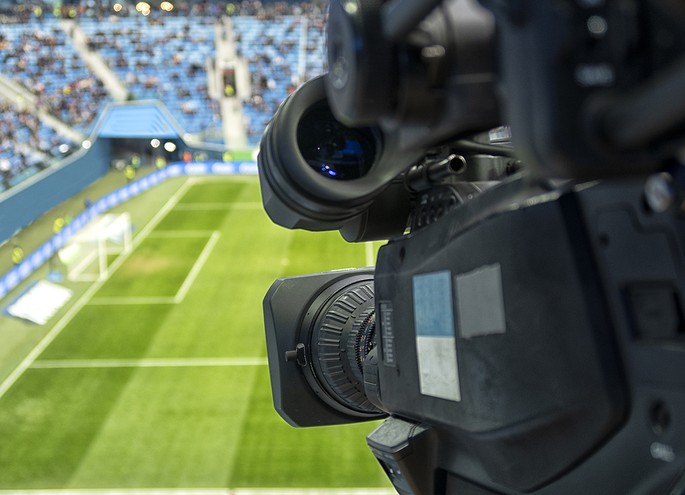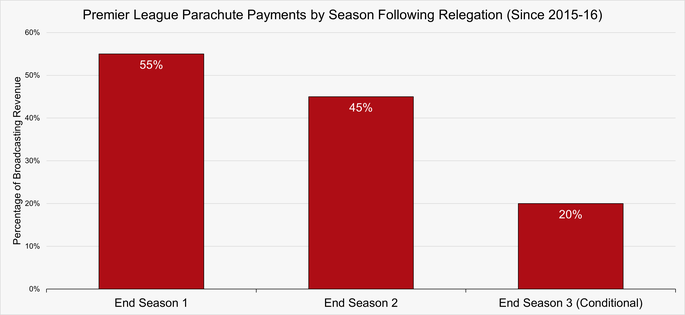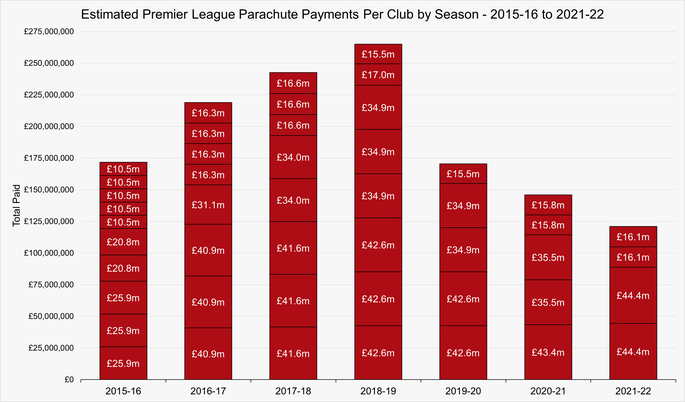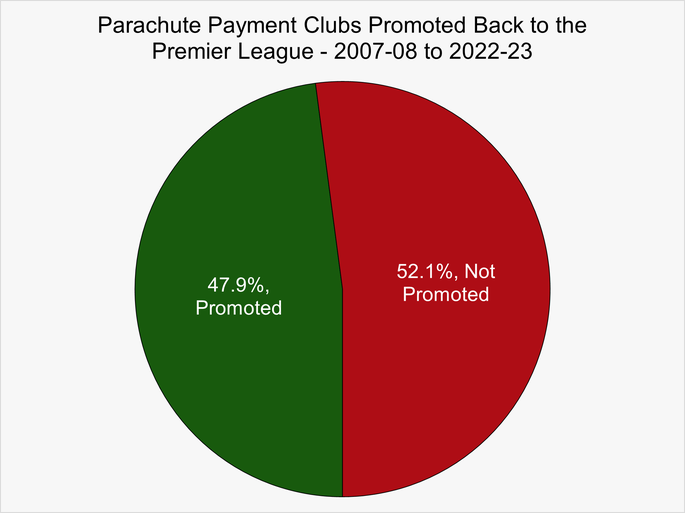![]() The difference between the Premier League and the Championship is vast in financial terms. In footballing terms, there is obviously a difference between the very top of the league and the newly promoted sides, but the sheer wealth of the English top-flight is such that the play-off game to see which team will be the third to be promoted out of the Championship alongside the top two is considered to be the richest match in football. Any club that is in the Premier League is considered to be a ‘shareholder’, with shareholders guaranteed a certain amount of money.
The difference between the Premier League and the Championship is vast in financial terms. In footballing terms, there is obviously a difference between the very top of the league and the newly promoted sides, but the sheer wealth of the English top-flight is such that the play-off game to see which team will be the third to be promoted out of the Championship alongside the top two is considered to be the richest match in football. Any club that is in the Premier League is considered to be a ‘shareholder’, with shareholders guaranteed a certain amount of money.
As a result, there is something of a cliff-edge for teams that drop out of the top-flight and back into the second tier of English football. Because of this, teams that get relegated receive parachute payments, which are designed to protect them from financial ruin. Of course, if the team then gets promoted back into the Premier League then the need to receive such payments is no longer there. When this happens, the parachute payments stop and the riches of the top-flight take over in terms of the club’s finances. The question is, how often does a team get back up with the payment period?
Quick Answer: How Often are Teams Promoted to the Premier League Whilst Covered by Parachute Payments?
Between the introduction of Parachute payments in 2006-07 and 2022-23, 23 out of the 48 relegated teams (47.9%) were promoted back to the Premier League whilst being eligible for parachute payments. The remaining 25 teams (52.1%) failed to gain promotion in their parachute period.
The parachute payment period was four seasons for teams relegated between 2006-07 and 2014-15, and has been three seasons for teams relegated since 2015-16.
Parachute Payments Explained

First things first, it is important to explain exactly how the parachute payment system actually works. Prior to the creation of the Premier League as the new-look top-flight in England, which was ahead of the 1992-93 season, payment from television companies was split between the top four divisions in the country. The First Division got 50% of it, with 25% paid to the Second Division and then 12.5% each to the Third and Fourth Divisions. When the Premier League was launched, the top-flight chose to keep hold of all of the money that it generated, with the exception being about £4 million a year.
That £4 million was spent on the likes of youth development, whilst Premier League teams taking part in the EFL Cup was done in order to add value to the competition. For the start of the 2006-07 campaign, a decision was taken to introduce ‘parachute’ payments. For two seasons following a club’s department from the top-flight, a club would receive half of the money that was paid to Premier League sides as part of the television broadcast deals. The idea behind the payments is to stop a club from being at risk of administration, which could happen thanks to the fact that they’ll have spend more in the Premier League.
When clubs are promoted, a lot of players will receive bonuses, whilst some might get a pay increase. Any new players signed in order to help them cope with the pressure of the top-flight will demand higher wages than they would have if the side had been in the Championship, so those high wages often still need to be paid after relegation. This meant that clubs could be in serious financial difficulty if not for the parachute payments, whilst an additional ‘solidarity payment’ of £1 million was also paid to the rest of the Championships clubs in order to stop the parachute payments from making the league less competitive.
Since they were first launched, both the structure of the parachute payments and solidarity payments and the value of them both have evolved and changed. When a TV deal is signed, the money from the deal tends to be split into three unequal parts. The first 50% is shared between all of the clubs in the Premier League for that season. The next 25% gets shared between club based on how often they’re shown on television, whilst the remaining 25% of split between the clubs depending on where they finish in the table, with clubs higher up getting more than those lower down.

The very concept of parachute payments is a curiously British one, with no other major league offering them. Of course, the Premier League is one of the richest divisions in the world, so others don’t have the same requirement to protect sides that are relegated out of it. At the time of writing, a club relegated to the Championship initially receives 55% of the broadcasting rights, which becomes 45% in the second year. What makes it slightly confusing is that some teams will then get 20% in the third year, provided they were in the top-flight for more than one season prior to being relegated.
Payments Since 2015-16
The payments structure listed above has been the case since the start of the 2015-16 season, with the previous system seeing clubs paid over four years rather than three. The key, at least as far as our question is concerned, is that in all variations of the situation the payments have stopped if a team gets promoted back into the Premier League. At that point, they instead get the payments that go to clubs simply for being part of the top-flight, so there is no need for them to get additional payments on top of that in order to be in a better financial situation than they would otherwise have been.
Here is a look at how teams have benefitted from the parachute payment structure since the start of 2015-2016 season until the 2021-2022 campaign. The chart below shows how much each qualifying side during the payment period received:

You can see from the chart how much the parachute payments tended to vary as the new system was introduced. You can also see that some clubs received a lot more money than others on account of how the system worked.
Criticism

Perhaps somewhat unsurprisingly, the parachute payment scheme has come under plenty of criticism since it was introduced. It is felt by many that such payments give an unfair advantage to the clubs that were relegated out of the Premier League, damaging the competitive nature of the Championship. Whilst solidarity payments exists, they are clearly nowhere near as high as the parachute payments tend to be. There is a feeling that the top-flight has a duty to try to help out across the leagues beneath them, not just with the teams that are in the Championship.
The nature of parachute payments is such that teams either already in the Premier League or promoted into it have less of a need to insert relegation clauses into a player’s contract. Such a clause would stipulate that the player would need to take a pay-cut in the event that the club was relegated out of the top-flight, which some believe would give them an added incentive to fight harder to stay up in the first place. The problem is, such clauses might also make it harder for teams to sign players in the first place, knowing that they’d be paid less if they went down.
Clubs Promoted During The Parachute Payment Period
The parachute payment scheme was introduced for the 2006-07 season. Between then and 2015-16, clubs were paid over four years. In 2015-16 that changed to being over three years, which obviously adds a degree of complication to proceedings. As a result, we assume that a club relegated in 2007, 2008, 2009, 2010, 2011, 2012, 2013, 2014 and 2015 would be given parachute payments until 2011, 2012, 2013, 2014, 2015, 2016, 2017, 2018 and 2019 respectively, which fits in with what we know from the payments made to clubs in the chart above.
Conversely, clubs relegated in 2016, 2017, 2018, 2019 and 2020 would’ve been given parachute payments until 2019, 2020, 2021, 2022 and 2023 respectively. We’re stopping at that point as that is the last point for which we have information. Here is a look at the clubs relegated during the relevant periods and whether or not they were promoted back into the Premier League during their parachute payment period:
2006-07 Relegated Teams
| Club | Promoted Before End 2010-11 |
|---|---|
| Sheffield United | ✖ |
| Charlton Athletic | ✖ |
| Watford | ✖ |
At the end of the 2006-07 season, the teams relegated were Sheffield United, Charlton Athletic and Watford. They had until 2011 to get promoted back into the Premier League during their parachute payment period. None of the teams went back up during this time period.
2007-08 Relegated Teams
| Club | Promoted Before End 2011-12 |
|---|---|
| Reading | ✖ |
| Birmingham City | ✅ (2nd in 2008-09) |
| Derby County | ✖ |
As the 2007-08 Premier League campaign drew to a close, Reading, Birmingham City and Derby County were all relegated to the Championship. They had until 2012 to collect parachute payments, with Birmingham City gaining promotion back to the top-flight at the end of the 2008-09 season. Neither of the other sides managed it.
2008-09 Relegated Teams
| Club | Promoted Before End 2012-13 |
|---|---|
| Newcastle United | ✅ (1st in 2009-10) |
| Middlesbrough | ✖ |
| West Bromwich Albion | ✅ (2nd in 2009-10) |
When the 2008-09 season was over, Newcastle United, Middlesbrough and West Bromwich Albion all went down. They had until 2013 to get back up and manage it within their parachute payment period. Newcastle and West Bromwich Albion both came straight back up, but Middlesbrough collected all four payments.
2009-10 Relegated Teams
| Club | Promoted Before End 2013-14 |
|---|---|
| Burnley | ✅ (2nd in 2013-14) |
| Hull City | ✅ (2nd in 2012-13) |
| Portsmouth | ✖ |
The three teams relegated at the end of the 2009-10 campaign were Burnley, Hull City and Portsmouth. They had until 2014 in order to get parachute payments, with Hull City making it back into the Premier League at the end of the 2012-13 season. Burnley, meanwhile, came back up at the end of the 2013-14 Championship season, so just within the parachute payment period.
2010-11 Relegated Teams
| Club | Promoted Before End 2014-15 |
|---|---|
| Birmingham City | ✖ |
| Blackpool | ✖ |
| West Ham United | ✅ (Play-Off Winner in 2011-12) |
When the 2010-11 season came to a conclusion, Birmingham City’s return to the Premier League was over. They were joined by Blackpool and West Ham United, with all three club having until 2015 to claim parachute payments. West Ham came straight back up, but the other two failed to do so.
2011-12 Relegated Teams
| Club | Promoted Before End 2015-16 |
|---|---|
| Bolton Wanderers | ✖ |
| Blackburn Rovers | ✖ |
| Wolverhampton Wanderers | ✖ |
As the conclusion of the 2011-12 campaign, Bolton Wanderers, Blackburn Rovers and Wolverhampton Wanderers went down. They were to be given parachute payments until 2016, with all three of them failing to be promoted during that time period.
2012-13 Relegated Teams
| Club | Promoted Before End 2016-17 |
|---|---|
| Wigan Athletic | ✖ |
| Reading | ✖ |
| Queens Park Rangers | ✅ (Play-Off Winner in 2013-14) |
The end of the 2012-2013 Premier League season saw supporters of Wigan Athletic, Reading and Queens Park Rangers dropping down into the Championship. They were to be given parachute payments until 2017, with Queens Park Rangers coming straight back up by neither of the other two managing it.
2013-14 Relegated Teams
| Club | Promoted Before End 2017-18 |
|---|---|
| Norwich City | ✅ (Play-Off Winner in 2014-15) |
| Fulham | ✅ (Play-Off Winner in 2017-18) |
| Cardiff City | ✅ (2nd in 2017-18) |
The three teams relegated out of the Premier League at the end of the 2013-14 season were Norwich City, Fulham and Cardiff City. They were due to be given parachute payments until 2018, which is exactly what happened with Cardiff City and Fulham. Norwich City, meanwhile, got straight back up.
2014-15 Relegated Teams
| Club | Promoted Before End 2018-19 |
|---|---|
| Hull City | ✅ (Play-Off Winner in 2015-16) |
| Burnley | ✅ (1st in 2015-16) |
| Queens Park Rangers | ✖ |
When the dust settled on the 2014-15 campaign, Hull City, Burnley and Queens Park Rangers all departed from the Premier League. The rules said that they were to get parachute payments until 2019, but Burnley were immediately promoted alongside Hull City so didn’t need them. Queens Park Rangers, meanwhile, collected them all.
2015-16 Relegated Teams
| Club | Promoted Before End 2018-19 |
|---|---|
| Newcastle United | ✅ (1st in 2016-17) |
| Norwich City | ✅ (1st in 2018-19) |
| Aston Villa | ✅ (Play-Off Winner in 2018-19) |
The end of the 2015-16 Premier League campaign saw Newcastle United, Norwich City and Aston Villa relegated. It was also when the situation changed and teams were only given parachute payments for three years until 2019. Newcastle United came straight back up and so didn’t need them, whilst Norwich and Aston Villa were both promoted back to the top-flight at the end of the 2018-19 season and so didn’t need the final instalment.
2016-17 Relegated Teams
| Club | Promoted Before End 2019-20 |
|---|---|
| Hull City | ✖ |
| Middlesbrough | ✖ |
| Sunderland | ✖ |
When the 2016-17 campaign reached its conclusion, Hull City were relegated again, as were Middlesbrough and Sunderland. They were due to get parachute payments until 2020, which all three of them did.
2017-18 Relegated Teams
| Club | Promoted Before End 2020-21 |
|---|---|
| Swansea City | ✖ |
| Stoke City | ✖ |
| West Bromwich Albion | ✅ (2nd in 2019-20) |
Swansea City, Stoke City and West Bromwich Albion were all relegated out of the top-flight at the end of the 2017-18 campaign, with the parachute payments due to be paid to them until 2021. West Bromwich Albion went back up in 2020, but the other two failed to be promoted in that period.
2018-19 Relegated Teams
| Club | Promoted Before End 2021-22 |
|---|---|
| Cardiff City | ✖ |
| Fulham | ✅ (Play-Off Winner in 2019-20) |
| Huddersfield Town | ✖ |
The relegated teams at the conclusion of the 2018-19 Premier League season were Cardiff City, Fulham and Huddersfield Town. They could collect parachute payments until 2022, with Fulham gaining promotion at the first time of asking, but the other two teams failing to get up again.
2019-20 Relegated Teams
| Club | Promoted Before End 2022-23 |
|---|---|
| Bournemouth | ✅ (2nd in 2021-22) |
| Watford | ✅ (2nd in 2020-21) |
| Norwich City | ✅ (1st in 2020-21) |
It was Bournemouth, Watford and Norwich City that dropped down to the Championship at the end of the 2019-20 campaign, with parachute payments due to be paid to them until 2023. Watford and Norwich both gained promotion back at the first time of asking, whilst Bournemouth went up the season after.
2020-21 Relegated Teams
| Club | Promoted Before End 2023-24 |
|---|---|
| Fulham | ✅ (1st in 2021-22) |
| West Bromwich Albion | ✖ |
| Sheffield United | ✅ (2nd in 2022-23) |
The end of the 2020-2021 season saw Fulham, West Bromwich Albion and Sheffield United relegated from the Premier League. They were due to be given parachute payments until 2024 and whilst we don’t have all of the information on that front, we do know that Fulham went straight back up, whilst Sheffield United gained promotion at the end of the 2022-23 Championship season.
2021-22 Relegated Teams
| Club | Promoted Before End 2024-25 |
|---|---|
| Burnley | ✅ (1st in 2022-23) |
| Watford | ✖ |
| Norwich City | ✖ |
The final season that we can tell you about with any sort of certainty is the 2021-2022 campaign, which saw Burnley, Watford and Norwich City relegated. The parachute payments were due to be made until 2025. We can’t tell you about the 2024 or 2025 seasons, but we do know that Burnley gained promotion back to the Premier League at the end of the 2022-23 season.
The Teams That Gained Promotion During The Parachute Payment Period
Although we’ve obviously explained in detail what happened each season in the above section, it is helpful to give a more concise outline of the teams that were promoted back into the Premier League during the period of time in which they were due to be given parachute payments. The chart below shows an overview of how often teams got promoted whilst able to receive parachute payments.

We can see that less that half of the 48 teams relegated (23) actually gained promotion back to the Premier League whilst able to collect parachute payments. So, despite the financial safety net, teams are more likely to remain in the EFL within this time frame.
In some ways, the above information shows how the parachute payment system helps teams but doesn’t allow them to properly establish themselves in either division. Newcastle United twice got relegated out of the Premier League and promoted back into it before the end of the parachute payment period, which is the same for West Bromwich Albion, Hull City and Fulham. Burnley and Norwich City, meanwhile, did it three times during the period of time that we’re looking at.
Is There An Alternative?

Seeing the manner in which the parachute payments essentially make some teams into zombie-clubs, stuck between the Premier League and the Championship without any real way of ensuring they get established in either division, the obvious question to ask is whether there is an alternative to the parachute payments. It is almost as if they are too much to allow fairness in the Championship but not enough to ensure teams can remain in the top-flight when they get back up. In 2022, the Premier League thought there was exactly that, proposing a radical alternative.
The idea that was mooted was that it should be merit-based, with teams paid according to their finish in the three divisions below the top-flight. It was felt that this would stop the relegated clubs from gaining too much of a financial advantage over the other clubs in the Championship. One of the stumbling blocks over the proposal was the fact that the Premier League wanted to maintain its control over the funding, based on the fact that many English Football League clubs had unsustainable business models and giving them more money wouldn’t help in the long-term.
